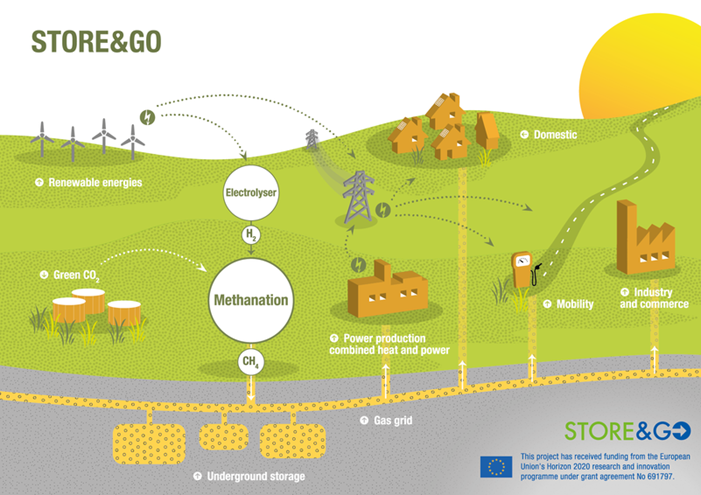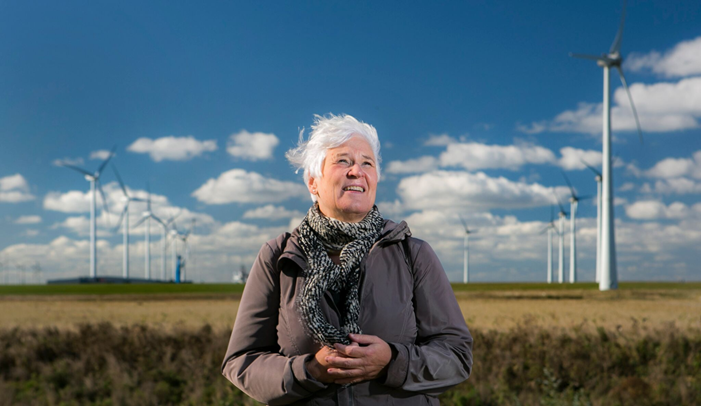The legal impact of innovative energy conversion and storage

The Groningen Centre of Energy Law (GCEL), the only knowledge center for energy law in the Netherlands, coordinates all law research of the Faculty of Law that relates to (parts of) the energy sector. One such research project is 'STORE&GO'. This project investigates the legal incorporation within the European Union of an innovative method of energy conversion and energy storage. This technique is also known as 'Power-to-Gas' (PtG).
Martha Roggenkamp, Professor of Energy Law:
What is Power-to-Gas (PtG)?
Both in the Netherlands and in the rest of Europe, the production and use of renewable energy sources such as wind and solar power are increasing enormously. This development brings a number of challenges related to the fluctuating nature of these energy sources. After all, electricity is not generated continuously but only when the sun shines or when there is a strong wind. As a result, supply and demand are not always in balance and this has direct consequences for the power grid. Imbalance can, in the worst case, lead to a blackout. One way to prevent this is to store excess energy for later use. Currently, large-scale electricity storage is not yet taking place but research is being conducted on a variety of electricity storage methods.
One such possibility is PtG. This is a technically innovative process that makes it possible to utilize surplus sustainably generated electricity by converting the electricity into hydrogen or synthetic natural gas via chemical conversion. The synthetic natural gas can then be stored in the existing gas grid or underground, and can then be used again to heat our homes, for example, or to generate electricity again.
The image below shows how electricity produced sustainably via PtG is eventually delivered to the end user as gas.

What are the legal issues involved in PtG?
Several legal issues usually arise when new techniques are applied. These range from whether a new technique can fit into the existing legal framework to the issue of how legislation can respond to new developments. Technical innovation often also requires renewal of existing legislation. So too with PtG.
What is innovative about PtG is the ability to produce a new type of gas from renewable energy and then store it for later use. How is such a technique and activity defined? Is it a form of electricity storage or gas production? Can this new gas also be considered a renewable gas? And what if the gas produced and stored is used again for electricity production? Because the energy sector is liberalized based on EU legislation and, as a result, energy production and supply companies are not allowed to be involved in network activities, strict rules apply to companies that want to combine production, network operation and storage. Thus, the legal impact of different definitions and categorization of PtG plants requires careful legal analysis.
There are also questions surrounding the injection of "new" gases such as hydrogen and biomethane into the existing gas network. For example, the quality and composition of the gas ultimately delivered to the end user must comply with legal standards. Another question is what regulations in the area of environmental law apply. For example, do the expedited and simplified permitting processes for renewable energy projects also apply to the development of PtG plants?
What will we notice about PtG in practice?
The social importance of PtG is multiple. First, the conversion of excess renewable electricity generated into gas ensures that the power grid does not become over- or underloaded, which could otherwise lead to blackouts. Second, the production of new gases contributes to energy security of supply. This is important as gas production declines not only in the Netherlands but throughout the EU. Large-scale application of PtG thus also makes Europe less dependent on gas supplies from countries outside the EU. Finally, producing gas from renewable energy sources contributes to reducing CO2 emissions and making our energy consumption more sustainable.
What is the approach to researching this?
In three locations within Europe (Germany, Falkenhagen; Switzerland, Solothurn; Italy, Troia), small-scale PtG pilot projects have been set up. At these locations, various techniques and methods of PtG are being tested. The pilot projects provide a range of information relevant to this research. Of interest to GCEL is how national and regional regulation of these projects is designed. Are there specific obstacles in the legislation and what solutions have been applied. Is there a need for a specific EU legislative framework? In addition to cooperation with operators of the pilot projects, we work closely with other researchers from inside and outside the RUG who are engaged in research on the technical and economic application of PtG. Thus, we are continuously looking at how law can contribute to the future realization of PtG.
With which parties is the (legal) research collaborating?
A total of 27 parties are involved in the entire STORE&GO project. These range from technical institutes such as the 'Deutscher Verein des Gas- und Wasserfaches' (DVGW) to private parties such as E.ON. In Groningen, in addition to the RUG, the Hanzehogeschool Groningen and the Energy Valley Foundation are also involved in the project. Moreover, within the RUG, three knowledge centers are participating in this Horizon 2020 project, namely the Groningen Centre of Energy Law (GCEL), the Centre of Energy and Environmental Sciences (IVEM) and the Centre for Energy Economics Research (CEER).
Prof. Dr Martha Roggenkamp, professor of Energy Law
Dr Ruven Fleming, associate professor of Energy law

| Last modified: | 15 July 2024 1.50 p.m. |
